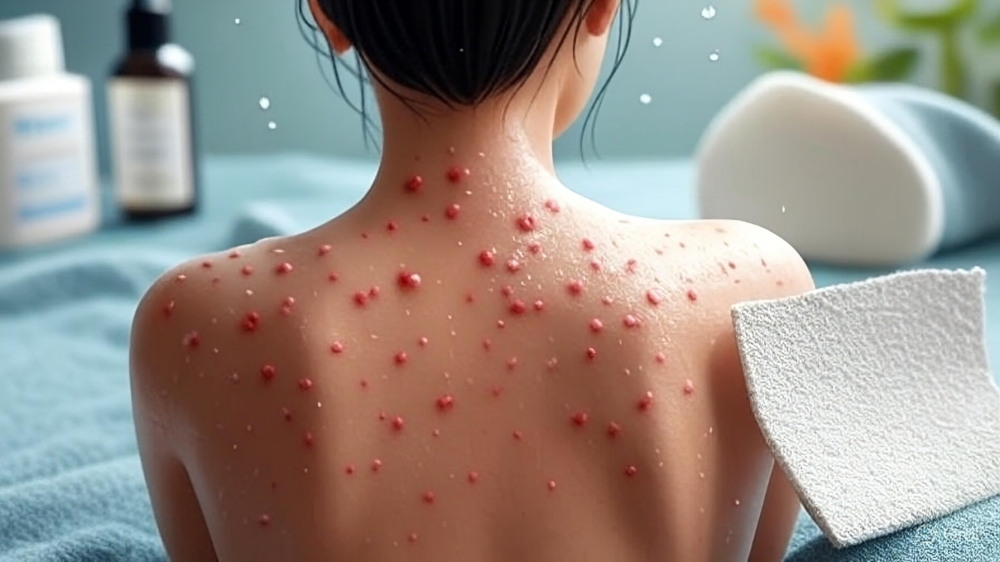Back acne, commonly known as “bacne,” affects millions of people worldwide and can be just as frustrating as facial acne. While it may be hidden under clothing, back acne can significantly impact your confidence and quality of life. The good news is that with the right approach, back acne is entirely treatable and preventable.
This comprehensive guide will walk you through everything you need to know about back acne, from understanding its root causes to implementing effective treatment strategies that deliver real results.
What Is Back Acne and Why Does It Happen?
Back acne occurs when hair follicles on your back become clogged with a combination of sebum (natural skin oil), dead skin cells, and bacteria. The back is particularly susceptible to acne because it contains numerous sebaceous glands that produce oil, and the area is often covered by clothing that can trap sweat and bacteria.
Understanding the Acne Formation Process
The development of back acne follows a predictable pattern:
- Excess oil production: Sebaceous glands produce more oil than necessary
- Dead skin cell accumulation: Old skin cells don’t shed properly
- Pore blockage: The combination creates plugs in hair follicles
- Bacterial growth: Propionibacterium acnes bacteria multiply in the clogged environment
- Inflammation: The body’s immune response causes redness, swelling, and pain
Types of Back Acne Lesions
Back acne can manifest in several forms:
- Blackheads: Open comedones with dark tops
- Whiteheads: Closed comedones that appear as small, white bumps
- Papules: Small, red, inflamed bumps
- Pustules: Pus-filled lesions with white or yellow centers
- Nodules: Large, painful lumps deep under the skin
- Cysts: Deep, pus-filled lesions that can cause scarring
What Causes Back Acne? Understanding the Root Factors
Hormonal Influences
Hormonal fluctuations are one of the primary drivers of back acne. During puberty, pregnancy, menstruation, and times of stress, hormone levels can trigger increased oil production. Androgens, particularly testosterone, stimulate sebaceous glands to produce excess sebum.
Genetic Predisposition
If your parents or siblings struggled with acne, you’re more likely to develop back acne. Genetics influence factors like:
- Sebaceous gland size and activity
- Skin cell turnover rate
- Inflammatory response patterns
- Hormone sensitivity
Lifestyle and Environmental Factors
Several daily habits and environmental conditions can contribute to back acne:
- Friction from clothing: Tight-fitting clothes, backpacks, and sports equipment
- Excessive sweating: Particularly when combined with occlusive clothing
- Poor hygiene practices: Infrequent showering or using harsh products
- Hair products: Conditioners and styling products that run down the back
- Stress: Elevates cortisol levels, which can worsen acne
- Diet: High-glycemic foods and dairy products may trigger breakouts in some individuals
Seasonal and Climate Considerations
Hot, humid weather can exacerbate back acne by increasing sweat production and creating an ideal environment for bacterial growth. Conversely, very dry conditions can cause the skin to overproduce oil as compensation.
Effective Treatment Strategies for Back Acne
Over-the-Counter Solutions That Work
1. Benzoyl Peroxide (2.5% – 10%)
Benzoyl peroxide is one of the most effective over-the-counter treatments for back acne. It works by:
- Killing acne-causing bacteria
- Reducing inflammation
- Helping to unclog pores
Application tip: Start with a lower concentration (2.5%) and gradually increase if needed. Leave wash-off formulations on the skin for 2-5 minutes before rinsing.
2. Salicylic Acid (0.5% – 2%)
This beta-hydroxy acid penetrates oil-filled pores and provides gentle exfoliation:
- Dissolves dead skin cells
- Reduces pore blockages
- Has anti-inflammatory properties
3. Adapalene Gel (0.1%)
Now available over-the-counter, this retinoid helps:
- Normalize skin cell turnover
- Prevent new comedones from forming
- Reduce existing acne lesions
Professional Treatment Options
For moderate to severe back acne, dermatological treatments may be necessary:
Prescription Topicals
- Tretinoin: Stronger retinoid for cell turnover regulation
- Clindamycin: Topical antibiotic for bacterial reduction
- Combination therapies: Products containing multiple active ingredients
Oral Medications
- Antibiotics: Doxycycline or minocycline for inflammatory acne
- Hormonal therapy: Birth control pills or spironolactone for hormonal acne
- Isotretinoin: For severe, cystic acne that doesn’t respond to other treatments
In-Office Procedures
- Chemical peels: Professional-strength acids for deep exfoliation
- Light therapy: Blue light or photodynamic therapy
- Extraction: Professional removal of comedones
- Intralesional injections: Corticosteroid injections for large cysts
Prevention Strategies: Your Daily Back Acne Defense Plan
Optimized Shower Routine
Timing and Frequency
- Shower immediately after sweating or working out
- Limit showers to once or twice daily to avoid over-drying
- Use lukewarm water instead of hot water
Product Selection and Application
- Choose gentle, non-comedogenic cleansers
- Apply conditioner before shampoo, or keep hair forward while rinsing
- Use a long-handled brush or loofah to reach all areas of your back
- Pat skin dry instead of rubbing vigorously
Clothing and Fabric Choices
Breathable Materials
- Opt for natural fibers like cotton or moisture-wicking synthetic fabrics
- Avoid tight-fitting clothing that can trap sweat and bacteria
- Change clothes immediately after exercising or sweating
Equipment Considerations
- Clean sports equipment regularly
- Use padding or barriers between equipment and skin
- Choose backpacks with padded, breathable straps
- Wash workout clothes after each use
Skincare Product Guidelines
What to Look For
- Non-comedogenic formulations
- Oil-free moisturizers and sunscreens
- Products with acne-fighting ingredients
- Fragrance-free options to reduce irritation
What to Avoid
- Heavy, occlusive products
- Products containing comedogenic ingredients
- Harsh scrubs that can worsen inflammation
- Sharing personal care items
Advanced Prevention: Addressing Underlying Factors
Dietary Considerations
While the relationship between diet and acne is still being studied, some evidence suggests certain foods may trigger breakouts:
Foods to Limit
- High-glycemic index foods (white bread, sugary snacks)
- Dairy products (particularly skim milk)
- Foods high in saturated fats
- Excessive amounts of chocolate or processed foods
Beneficial Foods
- Omega-3 rich fish
- Antioxidant-rich fruits and vegetables
- Whole grains
- Zinc-rich foods like pumpkin seeds and legumes
Stress Management
Chronic stress can worsen acne through hormonal pathways. Effective stress management techniques include:
- Regular exercise (followed by immediate showering)
- Meditation or mindfulness practices
- Adequate sleep (7-9 hours per night)
- Professional counseling when needed
Hormonal Balance
For those with hormonally-driven acne:
- Track breakouts in relation to menstrual cycles
- Discuss hormonal contraception options with healthcare providers
- Consider supplements like spearmint tea or zinc (under medical supervision)
- Address underlying conditions like PCOS
When to Seek Professional Help
Red Flags That Require Dermatological Care
- Cystic or nodular acne that’s painful and deep
- Acne that doesn’t improve after 6-8 weeks of consistent treatment
- Signs of scarring or post-inflammatory hyperpigmentation
- Emotional distress related to acne
- Acne accompanied by other symptoms like excessive hair growth or irregular periods
What to Expect During Your Dermatology Visit
Your dermatologist will:
- Assess the severity and type of your acne
- Review your current skincare routine and medical history
- Discuss treatment options and realistic timelines
- Create a personalized treatment plan
- Schedule follow-up appointments to monitor progress
Realistic Expectations and Timeline for Results
Treatment Timeline
- 2-4 weeks: Initial adjustment period; some irritation is normal
- 6-8 weeks: First signs of improvement should be visible
- 3-4 months: Significant clearing with consistent treatment
- 6-12 months: Optimal results and maintenance phase
Managing Expectations
- Some treatments may cause initial worsening before improvement
- Consistency is crucial for success
- Results vary based on acne severity and individual response
- Maintenance treatment is often necessary to prevent recurrence
Preventing and Treating Acne Scarring
Scar Prevention Strategies
- Never pick, squeeze, or pop acne lesions
- Use sunscreen daily to prevent post-inflammatory hyperpigmentation
- Start treatment early to minimize inflammation
- Keep skin moisturized to support healing
Scar Treatment Options
- Topical treatments: Retinoids, vitamin C, hydroquinone
- Professional procedures: Microneedling, laser therapy, chemical peels
- Injectable treatments: Dermal fillers for atrophic scars
The Emotional Impact: Addressing Psychological Effects
Back acne can significantly impact mental health and self-esteem. It’s important to:
- Acknowledge the emotional toll of acne
- Seek support from friends, family, or mental health professionals
- Remember that acne is a medical condition, not a reflection of personal hygiene
- Focus on overall health and well-being, not just appearance
Your Action Plan: Getting Started Today
Week 1-2: Foundation Building
- Establish a consistent shower routine
- Switch to non-comedogenic products
- Evaluate and modify clothing choices
- Start with gentle over-the-counter treatments
Week 3-4: Treatment Implementation
- Introduce active ingredients gradually
- Monitor skin response and adjust as needed
- Document progress with photos
- Maintain consistency with new routine
Month 2-3: Optimization and Professional Consultation
- Assess treatment effectiveness
- Consider professional help if needed
- Address any side effects or concerns
- Fine-tune routine based on results
Frequently Asked Questions
How long does it take to see results from back acne treatment?
Most people begin to see improvement within 6-8 weeks of consistent treatment. However, significant clearing typically takes 3-4 months, and optimal results may require 6-12 months of dedicated care.
Can I treat back acne at home, or do I need to see a dermatologist?
Mild to moderate back acne can often be successfully treated at home with over-the-counter products and lifestyle modifications. However, severe acne, cystic lesions, or acne that doesn’t respond to home treatment after 6-8 weeks should be evaluated by a dermatologist.
Is back acne caused by poor hygiene?
No, back acne is not caused by poor hygiene. While proper cleansing is important for treatment and prevention, acne is primarily caused by hormonal factors, genetics, and pore-clogging processes that occur beneath the skin’s surface.
Will back acne leave permanent scars?
Not all back acne will scar, but deeper lesions like cysts and nodules have a higher risk of causing permanent scarring. Early treatment and avoiding picking or squeezing lesions can significantly reduce the risk of scarring.
Can certain foods cause back acne?
While the relationship between diet and acne is still being researched, some studies suggest that high-glycemic foods and dairy products may trigger acne in susceptible individuals. However, dietary triggers vary from person to person.
Take Control of Your Back Acne Today
Back acne doesn’t have to be a permanent part of your life. With the right combination of proper skincare, lifestyle modifications, and professional treatment when needed, you can achieve clear, healthy skin on your back.
Remember that treating back acne requires patience and consistency. Start with the foundational steps outlined in this guide, and don’t hesitate to seek professional help if your acne is severe or doesn’t respond to over-the-counter treatments.
Your journey to clear skin starts today. Take the first step by implementing one or two changes from this guide, and gradually build a comprehensive routine that works for your unique skin needs. With dedication and the right approach, you can overcome back acne and regain your confidence.



